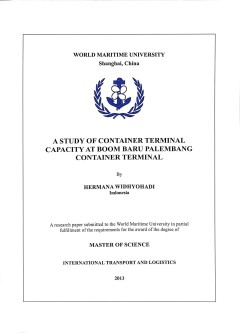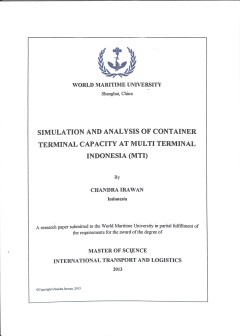Ditapis dengan

Port Congestion and Implications to Maritime Logistics
Ports are widely recognised as crucial nodes in international trade and transport. However, for various reasons, capacity does not always match demand: sometimes there is overcapacity, whereas in other cases, demand exceeds capacity and there is a shortage of the latter. This chapter therefore looks at where port congestion occurs, both globally and in the port-calling chain; it analyses actual…
- Edisi
- 04 Feb 2016; 49-68
- ISBN/ISSN
- 978-1-78052-340-8
- Deskripsi Fisik
- 23 P
- Judul Seri
- Maritime Logistics
- No. Panggil
- ATC LO MEE p

Biased random key genetic algorithm for the Tactical Berth Allocation Problem
The Tactical Berth Allocation Problem (TBAP) aims to allocate incoming ships to berthing positions andassign quay crane profiles to them (i.e. number of quay cranes per time step). The goals of the TBAPare both the minimization of the housekeeping costs derived from the transshipment container flowsbetween ships, and the maximization of the total value of the quay crane profiles assigned to the…
- Edisi
- 2014
- ISBN/ISSN
- -
- Deskripsi Fisik
- 18 p.
- Judul Seri
- Applied Soft Computing
- No. Panggil
- ATC LO RUI b

Study on berth planning problem in a container seaport: Using an integrated p…
This paper provides an integrated solution for two common processes in a container seaport: namely, the Berth Allocation Process (BAP) and the Crane Scheduling Process (QCSP). These are formulated through a Bi-Level Programming (BLP) approach, which is used to characterize the highly interrelated relationships between the two processes and simultaneously, identify an integrated solution for bot…
- Edisi
- -
- ISBN/ISSN
- 0360-8352
- Deskripsi Fisik
- 10 p.
- Judul Seri
- Computers & Industrial Engineering
- No. Panggil
- ATC PO ONG s

How to turn an innovative concept into a success? an application to seaport-r…
The main objective of this paper is ‘to assess the conditions, including policy support, under which innovative conceptshave a highchance ofgetting adoptedandbeingsuccessful’.Theworkwill start fromthe state-of-theart with the following goals targeted. Firstly, to identify the paths that newinnovative concepts usually follow, what key determinants are, which actors are involved, and what pol…
- Edisi
- -
- ISBN/ISSN
- 0739-8859
- Deskripsi Fisik
- 11 p.
- Judul Seri
- Research in Transportation Economics
- No. Panggil
- ATC PO ARD h

A Masters Guide to Berthing
- Edisi
- Second Edition
- ISBN/ISSN
- -
- Deskripsi Fisik
- 36 p
- Judul Seri
- -
- No. Panggil
- TXT PO MUR a
- Edisi
- Second Edition
- ISBN/ISSN
- -
- Deskripsi Fisik
- 36 p
- Judul Seri
- -
- No. Panggil
- TXT PO MUR a

Operations research for the management of a transhipment container terminal: …
In this work we describe some decisional problems arising in the management of maritime container ports, together with optimisation models and algorithms suitably designed for their solution. We refer to the Gioia Tauro container terminal which recently has reached a high stage of growth, becoming one of the most important transhipment ports in the Mediterranean Sea. In particular, we focus on …
- Edisi
- March 2009, Volume 11
- ISBN/ISSN
- -
- Deskripsi Fisik
- 20 p.
- Judul Seri
- Maritime Economics & Logistics
- No. Panggil
- ATC LO SAM o

A continuous berth template design model with multiple wharfs
Berth planning plays an important role in improving the efficiency of a container terminal. This study focuses on the berth template problem (BTP), which determines the berthing windows of the calling ships within a planning horizon (e.g. a week) in a cyclical way. As a mid-term tactical decision problem, BTP provides the decision support for a terminal operator to negotiate the contracts with …
- Edisi
- -
- ISBN/ISSN
- 0308-8839
- Deskripsi Fisik
- 14 p.
- Judul Seri
- The flagship journal of international shipping and port research
- No. Panggil
- ATC LO HUA a

Integrated berth allocation and quay crane assignment problem : set partition…
Most of the operational problems in container terminals are strongly interconnected. In this paper, we study the integrated Berth Allocation and Quay Crane Assignment Problem in seaport container terminals. We will extend the current state-of-the-art by proposing novel set partitioning models. To improve the performance of the set partitioning formulations, a number of variable reduction techni…
- Edisi
- -
- ISBN/ISSN
- -
- Deskripsi Fisik
- 23 p.
- Judul Seri
- -
- No. Panggil
- ATC PO LAR i

Artificial intelligence hybrid heuristic based on tabu search for the dynamic…
This paper considers the Dynamic Berth Allocation Problem, in which vessels are assigned to discrete positions in berths. This problem, whose goal is to minimize the total time the vessels stay at the port, constitutes one of the most important processes at any containers terminal. We propose a hybrid metaheuristic that combines Tabu Search with Path Relinking, T2SnþPR. The results reached by …
- Edisi
- -
- ISBN/ISSN
- -
- Deskripsi Fisik
- 10 p.
- Judul Seri
- Engineering Applications of Artificial Intelligence
- No. Panggil
- ATC LO MER a

An Integrated Model for Berth Template and Yard Template Planning in Transshi…
This paper studies two tactical level decision problems arising in transshipment hubs: berth template planning that is concerned with allocating berths and quay cranes to arriving vessels, and yard template planning that is concerned with assigning yard storage locations to vessels. These two tactical level decisions interact with each other. A mixed-integer programming model is proposed to int…
- Edisi
- Vol. 45, No. 4, November 2011
- ISBN/ISSN
- -
- Deskripsi Fisik
- 23 p.
- Judul Seri
- -
- No. Panggil
- ATC LO LEE a

A Study of Container Terminal Capacity At Boom Baru Palembang Container Terminal
Economic growth in a region indicated by increasing the growth of population and Gross Domestic Product (GDP). These two factors are used in determining variable takes into account forecasting container throughput in Palembang, South Sumatra. Container Terminal which is the parallel activities of the Berth and the Yard needs adequate capacity as benchmark capability in the meet of demand in the…
- Edisi
- -
- ISBN/ISSN
- -
- Deskripsi Fisik
- x, 65 p., : illus : table : 30 cm
- Judul Seri
- -
- No. Panggil
- TD PO WID a

Simulation And Analysis of Container Terminal Capacity At Multi Terminal Indo…
Within the development of seaport transportation system, note that the ability of a port plays an important role as a part of integrated global supply chain. As an indivisible share of a port, container terminal has a potential strategic value in the global liner shipping networks as well as a major aspect of the competitiveness of the The main objective �…
- Edisi
- -
- ISBN/ISSN
- -
- Deskripsi Fisik
- xiii, 100 p., : illus : table : diagram : 30 cm
- Judul Seri
- -
- No. Panggil
- TD PO IRA s
 Karya Umum
Karya Umum  Filsafat
Filsafat  Agama
Agama  Ilmu-ilmu Sosial
Ilmu-ilmu Sosial  Bahasa
Bahasa  Ilmu-ilmu Murni
Ilmu-ilmu Murni  Ilmu-ilmu Terapan
Ilmu-ilmu Terapan  Kesenian, Hiburan, dan Olahraga
Kesenian, Hiburan, dan Olahraga  Kesusastraan
Kesusastraan  Geografi dan Sejarah
Geografi dan Sejarah